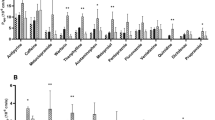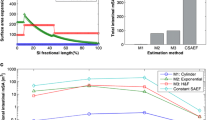Abstract
We propose an in vitro permeability assay by using a modified lipid membrane to predict the in vivo intestinal passive permeability of drugs. Two conditions were tested, one with a gradient pH (pH 5.5 donor/pH 7.4 receptor) and the other with an iso-pH 7.4. The predictability of the method was established by correlating the obtained apparent intestinal permeability coefficients (Papp) and the oral dose fraction absorbed in humans (fa) of 16 drugs with different absorption properties. The Papp values correlated well with the absorption rates under the two conditions, and the method showed high predictability and good reproducibility. On the other hand, with this method, we successfully predicted the transport characteristics of oral sulfadiazine (SDZ). Also, the tradeoff between the increase in the solubility of SDZ by its complex formation with cyclodextrins and/or aminoacids and its oral permeability was assessed. Results suggest that SDZ is transported through the gastrointestinal epithelium by passive diffusion in a pH-dependent manner. These results support the classification of SDZ as a high/low borderline permeability compound and are in agreement with the Biopharmaceutics Classification Systems (BCS). This conclusion is consistent with the in vivo pharmacokinetic properties of SDZ.






Similar content being viewed by others
References
Nirasay S, Mouget Y, Marcotte I, Claverie J. Supported bilayer on a nanopatterned membrane as model PAMPA membranes. Int J Pharm. 2011;421(1):170–5. https://doi.org/10.1016/j.ijpharm.2011.09.013.
Kansy M, Senner F, Gubernator K. Physicochemical high throughput screening: parallel artificial membrane permeation assay in the description of passive absorption processes. J Med Chem. 1998;41(7):1007–10. https://doi.org/10.1021/jm970530e.
Wohnsland F, Faller B. High-throughput permeability pH profile and high-throughput alkane/water log P with artificial membranes. J Med Chem. 2001;44(6):923–30. https://doi.org/10.1021/jm001020e.
Sugano K, Nabuchi Y, Machida M, Aso Y. Prediction of human intestinal permeability using artificial membrane permeability. Int J Pharm. 2003;257(1-2):245–51. https://doi.org/10.1016/S0378-5173(03)00161-3.
Sjögren E, Dahlgren D, Ross C, Lennemäs H. Human in vivo regional intestinal permeability: quantification using site-specific drug absorption data. Mol Pharm. 2015;12(6):2026–19. https://doi.org/10.1021/mp500834v.
Bujard A, Petit C, Carrupt P-A, Rudaz S, Schappler J. HDM-PAMPA to predict gastrointestinal absorption, binding percentage, equilibrium and kinetics constants with human serum albumin and using 2 end-point measurements. Eur J Pharm Sci. 2017;97:143–50. https://doi.org/10.1016/j.ejps.2016.11.001.
Stewart AM, Grass ME, Mudie DM, Morgen MM, Friesen DT, Vodak DT. Development of a biorelevant, material-sparing membrane flux test for rapid screening of bioavailability-enhancing drug product formulations. Mol Pharm. 2017;14(6):2032–46. https://doi.org/10.1021/acs.molpharmaceut.7b00121.
Sun H, Nguyen K, Kerns E, Yan Z, Yu KR, Shah P, et al. Highly predictive and interpretable models for PAMPA permeability. Biorg Med Chem. 2017;25(3):1266–76. https://doi.org/10.1016/j.bmc.2016.12.049.
Tsinman O, Tsinman K, Sun N, Avdeef A. Physicochemical selectivity of the BBB microenvironment governing passive diffusion-matching with a porcine brain lipid extract artificial membrane permeability model. Pharm Res. 2011;28(2):337–63. https://doi.org/10.1007/s11095-010-0280-x.
Bicker J, Alves G, Fortuna A, Soares-da-Silva P. A new PAMPA model using an in-house brain lipid extract for screening the blood-brain barrier permeability of drugs candidates. Int J Pharm. 2016;501(1–2):102–11. https://doi.org/10.1016/j.ijpharm.2016.01.074.
Sinkó B, Garrigues TM, Balogh GT, Nagy ZK, Tsinman O, Avdeef A, et al. Skin-PAMPA: a new method for fast prediction of skin penetration. Eur J Pharm. 2012;45(5):698–707. https://doi.org/10.1016/j.ejps.2012.01.011.
Bhardwaj R, Chandrasena G Optimal ADME properties for clinical candidate and investigational new drug (IND) package. In: Zhang D, Surapaneni S editors ADME-enabling technologies in drug design and development New Jersey: John Wiley & Sons, Hoboken; 2012. p. 15–28, DOI: https://doi.org/10.1002/9781118180778.ch2.
Avdeef A. The rise of PAMPA. Expert Opinion Drug Metabolism Toxicology. 2005;1(2):325–42. https://doi.org/10.1517/17425255.1.2.325.
Loftsson T, Konradsdottir F, Masson M. Development and evaluation of an artificial membrane for determination of drug availability. Int J Pharm. 2006;326(1-2):60–8. https://doi.org/10.1016/j.ijpharm.2006.07.009.
Loftsson T, ByskovVogensen S, Brewster M, Konráδsdóttir F. Effects of cyclodextrins on drug delivery through biological membranes. J Pharm Sci. 2007;96(10):2532–46. https://doi.org/10.1002/jps.20992.
Loftsson T, Brewster M. Pharmaceutical applications of cyclodextrins: effects on drug permeation through biological membranes. J Pharm Pharmacol. 2011;63(9):1119–35. https://doi.org/10.1111/j.2042-7158.2011.01279.x.
Zoppi A, Quevedo MA, Delrivo A, Longhi MR. Complexation of sulfonamides with beta-cyclodextrin studied by experimental and theoretical methods. J Pharm Sci. 2010;99(7):3166–76. https://doi.org/10.1002/jps.22062.
Delrivo A, Zoppi A, Longhi M. Interaction of sulfadiazine with cyclodextrins in aqueous solution and solid state. Carbohyd Polym. 2012;87(3):1980–8. https://doi.org/10.1016/j.carbpol.2011.10.025.
Delrivo A, Zoppi A, Granero G, Longhi M. Studies of ternary systems of sulfadiazine with β-cyclodextrin and aminoacids. Ars Pharm. 2016;57(4):167–76.
Amidon GL, Sinko PJ, Fleisher D. Estimating human oral fraction dose absorbed, a correlation using rat intestinal membrane permeability for passive and carrier mediated compounds. Pharm Res. 1988;5(10):651–4. https://doi.org/10.1023/A:1015927004752.
CDER/FDA, U. S. (2000). Guidances for industry: waiver of in vivo bioavailability and bioequivalence studies for immediate-release solid oral dosage forms based on a Biopharmaceutics Classification System.
Kim JS, Mitchell S, Kijek P, Tsume Y, Hilfinger J, Amidon GL. The suitability of an insitu perfusion model for permeability determinations: utility for BCS Class I biowaiver requests. Mol Pharm 2006;3:686–694.
Varma MV, Gardner I, Steyn J, Nkansah P, Rotter CJ, Whitney-Pickett C, Zhang H, Di L, Cram M, Fenner KD, El-Kattan AF. pH-dependent solubility and permeability criteria for provisional Biopharmaceutics Classification (BCS and BDDCS) in early drug discovery. Mol Pharm 2012;9:1199–1212.
Kotecha J, Sha S, Rathod I, Subbaiah IR. Prediction of oral absorption in humans by experimental immobilized artificial membrane chromatography indices and physicochemical descriptors. Int J Pharm 2008;360:96–106.
Larregieu CA, Benet LZ. Distinguishing between the permeability relationship with absorption and metabolism to improve BCS and BDDCS predictions in early drug discovery. Mol Pharm. 2014;11(4):1335–44. https://doi.org/10.1021/mp4007858.
Sugano K, Hamada H, Machida M, Ushio H, Saitoh K, Terada K. Optimized conditions of bio-mimetic artificial membrane permeation assay. Int J Pharm 2001;228:181–8.
Corti G, Maestrelli F, Cirri M, Zerrouk N, Mura P. Development and evalueation of an in vitro method for prediction of human drug absorption II. Demonstration of the method suitability. Eur J Pharm Sci 2006;27:354–362.
Tam KY, Avdeef A, Tsinman O, Sun N. The permeation of amphoteric drugs through artificial membranes – An in combo absorption model based on paracellular and transmembrane permeability. J Med Chem 2010;53:392–401.
Meadows KE, Nadappuram BP, Unwin PR. A new approach for the fabrication of microscale lipid bilayers at glass pipets: application to quantitative passive permeation visualization. Soft Matter. 2014;10(42):8433–41. https://doi.org/10.1039/C3SM51406D.
Flanagan SD, Takahashi LH, Liu X, Benet LZ. Contributions of saturable active secretion, passive transcellular, and paracellular diffusion to the overall transport of furosemide across adenocarcinoma (Caco-2) cells. J Pharm Sci. 2002;91(4):1169–77. https://doi.org/10.1002/jps.10099.
Granero G, Longhi M, Mora M, Junginger H, Midha K, Shah V, et al. Biowaiver monographs for immediate release solid oral dosage forms: furosemide. J Pharm Sci. 2010;99(6):2544–56. https://doi.org/10.1002/jps.22030.
Incecayir T, Tsume Y, Amidon GL. Comparison of the permeability of metoprolol and labetalol in rat, mouse, and caco-2 cells: use as a reference standard for BCS classification. Mol Pharm. 2013;10(3):958–66. https://doi.org/10.1021/mp300410n.
Dahan A, Miller JM, Hilfinger JM, Yamashita S, Yu LX, Lennernäs AGL. High-permeability criterion for BCS classification: segmental/pH dependent permeability considerations. Mol Pharm. 2010;7(5):1827–34. https://doi.org/10.1021/mp100175a.
Toyozo U, Yutaka S. Studies on the metabolism of sulfadiazine. II. quantitative separation of excrements in the human urine after administration of sulfadiazine. Chem Pharm Bull. 1966;14(7):687–91.
Van Petten GR, Becking GC, Withey RJ, Lettau F. Studies on the physiological availability and metabolism of sulfonamides. I. sulfadiazine. J Clin Pharmacolog. 1971;11:27–34.
Männistö P, Tuomisto J, Sairs N-E, Lehtinen T. Pharmacokinetic studies with trimethoprim and different doses of sulfadiazine in healthy human subjects. Chemotherapy. 1973;19(5):289–98. https://doi.org/10.1159/000221467.
Vree TB, de Ven ES, Verwey-van W, et al. Isolation, identification and determination of sulfadiazine and its hydroxy metabolites and conjugates from man and Rhesus monkey by high-performance liquid chromatography. J Chromatograph B: Biomed Sci Applic. 1995;670(1):111–23. https://doi.org/10.1016/0378-4347(95)00163-D.
Ritschel WA, Erni W. Bioavailability of sulfadiazine in rabbits using tablets prepared by direct compression and fluidized-bed granulation. J Pharm Sci. 1977;66(10):1438–41. https://doi.org/10.1002/jps.2600661023.
Nielsen P, Gyrd-Hansen N. Oral bioavailability of sulphadiazine and trimethoprim in fed and fasted pigs. Res Vet Sci. 1994;56(1):48–52. https://doi.org/10.1016/0034-5288(94)90195-3.
Fine-Shamir N, Beig A, Zur M, Lindley D, Miller JM, Dahan A. Toward successful cyclodextrin based solubility-enabling formulations for oral delivery of lipophilic drugs: solubility-permeability trade-off, biorelevant dissolution, and the unstirred water layer. Mol Pharm. 2017;14(6):2138–46. https://doi.org/10.1021/acs.molpharmaceut.7b00275.
Beig A, Miller JM, Lindley D, Dahan A. Striking the optimal solubility-permeability balance in oral formulation development for lipophilic drugs: maximizing carbamazepine blood levels. Mol Pharm. 2017;14(1):319–27. https://doi.org/10.1021/acs.molpharmaceut.6b00967.
Holm R, Olesen NE, Hartvig RA, Jorgensen EB, Larsen DB, Westh P. Effect of cyclodextrin concentration on the oral bioavailability of danazol and cinnarizine in rats. Eur J Pharm Biopharm. 2016;101:9–14. https://doi.org/10.1016/j.ejpb.2016.01.007.
Amidon GL, Lennernås H, Shah VP, Crison JR. Theoretical basis for a biopharmaceutical drug classification: the correlation of in vitro drug product dissolution and in vivo bioavailability. Pharm Res. 1995;12:413–20.
Acknowledgements
The authors wish to acknowledge the assistance of the Consejo Nacional de Investigaciones Científicas y Técnicas (CONICET), the Secretaría de Ciencia y Técnica de la Universidad Nacional de Córdoba (SECyT-UNC), and Fondo para la Investigación Científica y Tecnológica (FONCYT) which provided support and facilities for this investigation. We also thank Ferromet S.A. (agent of Roquette in Argentina) for their donation of cyclodextrins and DROMEX SA Argentina for the gift of Lipoid 75.
Author information
Authors and Affiliations
Corresponding author
Rights and permissions
About this article
Cite this article
Delrivo, A., Aloisio, C., Longhi, M.R. et al. Artificial Lipid Membrane Permeability Method for Predicting Intestinal Drug Transport: Probing the Determining Step in the Oral Absorption of Sulfadiazine; Influence of the Formation of Binary and Ternary Complexes with Cyclodextrins. AAPS PharmSciTech 19, 1437–1447 (2018). https://doi.org/10.1208/s12249-018-0965-8
Received:
Accepted:
Published:
Issue Date:
DOI: https://doi.org/10.1208/s12249-018-0965-8




